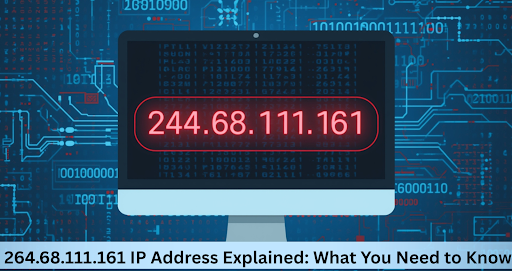The world of IP addresses can seem daunting, especially when faced with a string of numbers like 264.68.111.161. This address may pop up in your network logs or during troubleshooting sessions, leaving you wondering about its validity and significance. In an era where digital security and connectivity are paramount, understanding what this specific IP address represents is essential for both tech enthusiasts and everyday users alike.
Whether you’re managing a network or simply curious about how to find an IP address, grasping the details surrounding IPv4 addresses is crucial. So let’s dive into everything you need to know about 264.68.111.161—its importance, technical aspects, potential risks, and how you can navigate any challenges it presents in your system.
What Is 264.68.111.161 and Why It Matters
264.68.111.161 is an intriguing sequence in the world of internet connectivity, representing a specific IP address within the IPv4 format. This type of address serves as a unique identifier for devices connected to networks, allowing them to communicate effectively over the vast expanse of the internet.
Understanding why this particular IP matters can help users recognize its role in networking. Each device that connects to the internet requires an address to send and receive data packets smoothly. As such, 264.68.111.161 could be tied to various functions or services online, from web hosting to remote access tools.
For network administrators and IT professionals, awareness of addresses like this one is vital when monitoring traffic patterns, performing network troubleshooting, or diagnosing IP configuration errors related to connectivity problems or unauthorized access attempts.
On a broader scale, grasping what this specific IP may signify can enhance your understanding of digital infrastructure and security measures required for safe browsing experiences. Recognizing how often certain addresses appear in logs helps identify potential anomalies or threats lurking within your network environment.
Thus, 264.68.111.161 isn’t just another string of numbers; it holds significance that extends beyond mere identification—acting as a key element in maintaining efficient communication across our interconnected digital landscape.
Is 264.68.111.161 a Valid IPv4 Address?
When discussing networking, the validity of an IP address is crucial for effective communication between devices. The address 264.68.111.161 raises questions due to its structure and numerical values.
IPv4 addresses consist of four octets, separated by periods. This means valid IPv4 addresses must adhere strictly to this format to function properly on a network.
In the case of 264.68.111.161, the first octet exceeds this limit significantly, as it reads “264.” Since no individual segment in an IPv4 address can surpass 255, we can quickly determine that this particular address is invalid within the context of standard networking protocols.
An invalid IP address like this may arise from typographical errors or misconfigurations in IP settings when entering data into routers, DNS entries, or network logs. Such mistakes can lead users to misunderstand their network environments and cause connectivity issues.
Identifying incorrect IP addresses is essential for effective network troubleshooting. Many IT experts rely on automated validation tools to check for anomalies or improper entries that violate the IPv4 format.
Understanding whether an IP address is valid helps maintain a smooth-functioning system and ensures that all devices are properly communicating within defined parameters, which ultimately contributes to overall network health and efficiency.
Technical Breakdown of 264.68.111.161 in Networking
The IP address 264.68.111.161 consists of four octets separated by periods, a standard for IPv4 addressing. Each octet can range from 0 to 255; however, this specific combination breaks that rule.
The first octet “264” exceeds the maximum allowable value. This technicality indicates that 264.68.111.161 cannot be used as a legitimate IP address in any network setup or automatic private IP addressing (APIPA) scenario.
IPv4 addresses serve as unique identifiers within networks, enabling devices to transmit and receive data efficiently. Due to its invalid nature, you won’t find devices assigned such an address on global routing tables or DNS servers—the backbone components of internet functionality.
When analyzing network traffic logs or utilizing tools like traceroute or ping tests, encountering this sequence signals either software reporting errors or data entry mistakes, rather than legitimate usage. Understanding these technical aspects enhances your grasp of networking fundamentals while underlining that not all numerical combinations adhere to proper Internet Protocol standards.
Why 264.68.111.161 Appears in Logs or Tools
The appearance of 264.68.111.161 in logs or monitoring tools can often raise questions among users and administrators alike. This IP may show up due to various activities happening within a network environment.
One common reason involves misconfigured devices. Incorrect IP address settings can lead to entries like this appearing in routers, DHCP tables, or event logs. Sometimes, the system may default to an invalid address during automatic private IP addressing when it fails to obtain one from a DHCP server.
Another possible cause relates to software glitches or API miscommunication between diagnostic utilities. Tools that help users learn how to find IP addresses might report data incorrectly due to cache or configuration issues.
It’s also possible for 264.68.111.161 to be flagged during security audits when analyzing traffic patterns on your network. Such investigations help detect unauthorized access attempts or suspicious endpoints.
When using services like VPNs, proxies, or web hosting platforms, routing paths can create temporary traces of such anomalous IPs, even if they don’t correspond to real devices.
Security Risks Related to 264.68.111.161
When discussing security risks tied to specific IP addresses, 264.68.111.161 often raises concerns. Even though it’s not a valid IPv4 address, its presence in logs might suggest attempted spoofing or network probing by malicious actors.
Cybercriminals sometimes use random IP addresses or synthetically generated sequences like this to bypass firewalls or confuse administrators. These attempts may be linked to automated bot attacks, malware delivery systems, or Distributed Denial-of-Service (DDoS) attempts.
Repeated log entries from 264.68.111.161 could indicate probing activities that exploit weak firewall rules or unpatched vulnerabilities. While not inherently dangerous itself, it’s often a red flag for potential intrusion attempts.
Network administrators should take a proactive stance—analyzing patterns, updating security policies, and blocking repeated invalid IP activity. Implementing IP reputation monitoring tools and automated blocking mechanisms enhances protection.
How to Troubleshoot 264.68.111.161 in Your System
If 264.68.111.161 frequently appears in your system, effective network troubleshooting becomes essential. Start by verifying your router settings and ensuring all devices have valid IP assignments. Misconfigurations or overlapping ranges can generate phantom IPs.
Run a full network scan with updated antivirus and security tools to detect suspicious traffic. If you suspect corruption in your DNS records, flush your DNS cache using the command ipconfig /flushdns.
If you’re learning how to change an IP address, ensure your configurations comply with valid IPv4 ranges. Examine your firewall logs to identify connections involving 264.68.111.161, as these can reveal whether the issue stems from external attempts or internal misconfigurations.
Checking device IPs through router dashboards or command-line tools like ipconfig (Windows) or ifconfig (macOS/Linux) can help find device IP addresses linked to the anomaly.
Should irregularities persist, seek help from IT professionals who specialize in advanced network diagnostics and cybersecurity audits.
What to Do If You Encounter 264.68.111.161 Frequently
Frequent encounters with 264.68.111.161 may suggest deeper network misconfigurations or faulty logs. Begin by analyzing where the address appears—server logs, API reports, or intrusion detection tools.
If it’s recorded in your web server logs, study the request patterns. Are they legitimate web hits, or do they resemble probing attempts? Use reverse DNS lookup tools to check for recognizable origins.
Enable rate limiting or firewall rules to prevent repeated traffic from questionable IPs. Keeping logs helps track patterns over time and assists in refining your network monitoring strategy.
If such addresses appear across multiple systems, it could signal a wider issue with automatic private IP addressing or erroneous DNS entries. Addressing the root cause ensures your network remains stable and secure.
Understanding the Format Error in 264.68.111.161
Understanding the format error in 264.68.111.161 is essential for anyone managing networked systems. Since IPv4 follows a strict numerical limit (0–255 per octet), “264” invalidates this address completely.
This invalidity often results from manual entry errors, faulty scripts, or test data generated during network configuration checks. The solution involves verifying that all address inputs conform to valid IPv4 structure and avoiding random IP address inputs that fall outside acceptable parameters.
Whenever you encounter invalid IP addresses, treat them as warnings that your configuration, software, or diagnostic tools may require inspection. Understanding this helps preserve optimal performance and prevent connectivity disruptions across your network.
Final Takeaway
While 264.68.111.161 may appear mysterious, it ultimately serves as a valuable reminder about the importance of accuracy in IP configuration, network security, and troubleshooting. Recognizing the difference between a valid and invalid IP address can help maintain efficient connectivity and protect systems from unnecessary




